Indigenous trail crews empower the next generation of environmental stewards
By Cecilia Curiel
For the last several years, Shonto Greyeyes of the Diné (Navajo) Nation has made his living in some of the Southwest’s most sought-after landscapes—from the Red Rock District in Sedona, Arizona, to Utah’s Grand Staircase Escalante National Monument. Greyeyes got his start doing river restoration for Coconino Rural Environmental Corps, based out of Flagstaff, Arizona. Following his time at Coconino, he moved north to work in Montana before returning to the Southwest to lead high school conservation crews in Williams, Arizona, intern at the Red Rock Ranger District, and lead adult crews in Grand Staircase for the Arizona Conservation Corps. He now serves as a program coordinator for the Ancestral Lands Conservation Corps.
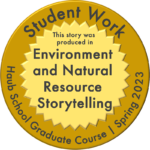 I spoke to Greyeyes while he tabled at the Nizhoni Days Pow Wow in Albuquerque, New Mexico. With the sound of voices, drums, and laughter in the background, he described the impact that Ancestral Lands and programs like it can have for Indigenous peoples. The Ancestral Lands Conservation Corps aims to engage Indigenous youth and young adults in conservation and land management through hands-on service projects. Like other conservation corps programs, Ancestral Lands crews work with government agencies and private organizations on trail building and maintenance, ecological restoration, historical preservation, fire prevention, and more. However, they do this work with the added goal of restoring Indigenous peoples’ historical connection to the land. Or as Greyeyes put it, such programs can “lead our nations back to ecological and cultural wellbeing.”
I spoke to Greyeyes while he tabled at the Nizhoni Days Pow Wow in Albuquerque, New Mexico. With the sound of voices, drums, and laughter in the background, he described the impact that Ancestral Lands and programs like it can have for Indigenous peoples. The Ancestral Lands Conservation Corps aims to engage Indigenous youth and young adults in conservation and land management through hands-on service projects. Like other conservation corps programs, Ancestral Lands crews work with government agencies and private organizations on trail building and maintenance, ecological restoration, historical preservation, fire prevention, and more. However, they do this work with the added goal of restoring Indigenous peoples’ historical connection to the land. Or as Greyeyes put it, such programs can “lead our nations back to ecological and cultural wellbeing.”
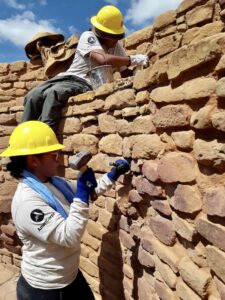
Ancestral Lands is now the model for a much larger initiative. In the summer of 2022, the US Department of the Interior launched the Indian Youth Service Corps (IYSC), meant to provide employment and training for young Indigenous peoples, as well as to “increase Tribal engagement in environmental stewardship activities.” Through her role leading the department, Secretary of Interior Deb Haaland of the Laguna Pueblo Nation has ensured that Indigenous stewardship is part of efforts to address topics such as climate change and environmental justice. The Interior Department’s role, Haaland said in her acceptance speech to the position, is “not simply about conservation—[it’s] woven in with justice, good jobs, and closing the racial wealth gap.”
Both Greyeyes and Secretary Haaland see corps programs as not only a means of employment and community service, but also an opportunity to reengage Indigenous people in stewarding the landscapes they inhabited for thousands of years before systematic removal by the US government. The IYSC can contribute to community resilience by promoting ecological and social restoration, shared knowledge, and skill development. Achieving these goals—if history has taught us anything—will largely depend on how well programs integrate Indigenous knowledge and values.
~
Programs like the IYSC and Ancestral Lands have a long historical precedent going back to the Civilian Conservation Corps (CCC) under President Franklin Roosevelt’s New Deal. The CCC was intended to provide employment and economic relief for young men in response to the Great Depression. Many viewed the distress experienced by displaced workers who could no longer provide for themselves or their families not only as a financial burden, but a social and psychological one. The CCC was Roosevelt’s answer to mending these problems. In fact, historian John Paige notes that the program was steeped in ideas for social and cultural development, with influence from 19th-century philosopher William James who wrote that such programs would make men, “tread the earth more proudly, the women would value them more highly, they would be better fathers and teachers of the following generation.” While this sentiment clearly leaves out the active role of women, it shows that conservation corps programs were more than tools for employment, but active in social construction and community building.
While the Civilian Conservation Corps was widely developed for white men in a still-segregated 1930s America, it did recognize the hardships that the Great Depression placed on Indigenous and Black Americans, creating divisions for both. The CCC Indian Division did not suddenly dispel the difficulties that Indigenous people have and continue to endure, but the program was largely lauded as a success within Native communities, especially when compared with other policies of the time.
For example, the 1934 Indian Reorganization Act, implemented just one year after the CCC, intended to restore Indigenous cultural knowledge, strengthen tribal governments, and promote native traditions as a counter to earlier government policies of Native American assimilation. However, it relied on US government authority to enact many of its stated goals, and the program failed to promote tribal autonomy and cultural resilience.
The CCC Indian Division, on the other hand, had the simple goal of providing employment and training to Indigenous peoples while making improvements to both tribal land and government land that other divisions of the CCC worked. The training prepared Native American participants to eventually hold over 750 of the approximately 1,200 managerial positions in the CCC Indian Division. This was a key difference from the Indian Reorganization Act, which was largely run by white governmental officials. The acknowledgement that Indigenous peoples were best suited to make decisions in Indigenous affairs was a critical element of the CCC Indian Division’s success.
~
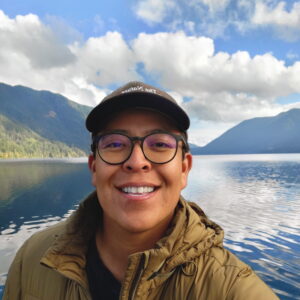
That self-determination is something that Ancestral Lands and the IYSC strive to replicate. “If we have people from our communities that look like us performing these tasks and showing up authentically through failure and success, the whole process,” Greyeyes says, “when we see our people doing it, you know, it becomes a possibility.” But truly empowering marginalized communities, Greyeyes emphasizes, also requires creating the opportunities and mechanisms for them to succeed. “If I could train myself out of a job,” Greyeyes continues, “that would be ideal.”
Training crew members to move up in the organization isn’t the only goal of programs like Ancestral Lands and the IYSC. They want crew members to take their training into the community. Shamira Caddo of the White Mountain Apache Nation describes starting her work in conservation. “At the time, there were no jobs on the reservation,” she says. So when she got a call from the Arizona Conservation Corps White Mountain Apache office she jumped at the chance, even though she wasn’t quite sure what she had signed up for. All she knew was that she needed to be at “Pinetop, with camping gear and clothes for, like, eight days.” Her first days at Arizona Conservation Corps were “a crash course” operating chainsaws to clean up after wildfire and clear trails. This was her first job off the reservation, and she eventually became a crew leader. Caddo says one of the most influential parts of her experience was, “being exposed to different departments within the BIA [Bureau of Indian Affairs] or Park Service, or, state, local and federal agencies. It was like, wow, you know, they actually have these jobs. And I can actually do them.” She now works at a farm in Minnesota that brings Indigenous practices into the community through garden projects, and she credits her chainsaw training in part. “That’s one of the reasons why this organization hired me, “she told me. “They needed sawyers on the farm.”
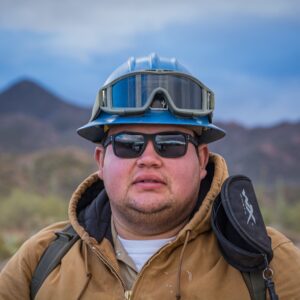
The corps offer more than just skill-building. Many of the corps members I spoke with explained that conservation programs meant their first chance to leave the reservation and engage with their ancestral lands. Maasai Leon, of the Chiricahua Apache Nation, has been working in conservation for several years, including recruiting Indigenous members for the Arizona Conservation Corps. He explained that many of the crew members he worked with had never left their reservation. “And those that had,” he says, “have never really seen a lot of the national parks and monuments and areas that we work in.” Programs like IYSC and Ancestral Lands reconnect Indigenous peoples to land they were violently displaced from by the creation of our national forests and parks. These programs offer a renewed opportunity to help Indigenous youth understand “the connections that we have to place and how it’s been disrupted through the creation of parks and forests,” Greyeyes tells me. “In a larger wellness community aspect, [it’s about] creating opportunities for young Indigenous people to develop their own story and develop their own narratives as a part of their identities when working in parks.”
Working these lands, Leon explains, is important for Indigenous youth to engage their past. For example, one crew worked on a historical preservation project on Fort Bowie, where many Indigenous peoples were held prisoner during the Indian Wars. “It would be wise to put Native people on that trail to know the history,” Leon says, explaining that understanding the complexities of historical sites, the legacy of settlement, and the nuance of tribal relations is important for Indigenous peoples.
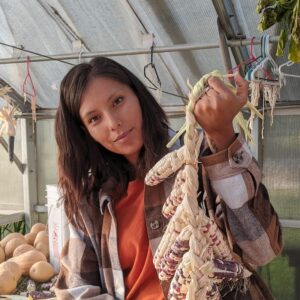
This gets at another mission of programs like Ancestral Lands and IYSC: to foster community resilience by creating and sustaining cultural lines of heritage through interaction and passing knowledge from one generation to the next. This is why, Leon says, when the crews are together, he tells stories, especially those involving other tribes represented on the crew. “I always encourage people to learn more about their culture,” he says. “And if there was any way that we could provide more information for them, or put them in touch with an elder, we would.” Opportunities like these are important in keeping alive the knowledge and traditions that Indigenous peoples share through story.
Leon offered another example of a crew member working with Anasazi artifacts, explaining that for his people, the Diné, coming into contact with such ancient cultural pieces meant he needed to perform a cleansing ceremony known as smudging. Leon continued, “When it comes to ceremonies, we’re very understanding, you know…if someone needs to go to a ceremony, we will work with the individual to try to get them to wherever they need to go.” Caddo shared a similar experience of a young Navajo crew member who refrained from sleep during a lunar eclipse as part of a tradition passed down from his grandmother. Caddo says she had to think on her feet, but because time off for ceremonies is structured into the Ancestral Lands program, it was easier to make adjustments for the crew member. Making space for ceremony within conservation programs represents a different way of being with the land, of recognizing Indigenous peoples’ stories and ceremony in conservation.
Caddo, Greyeyes, and Leon’s experiences help us understand how Indigenous conservation crews can empower young Indigenous peoples to carry knowledge into the wider community. In calling for a national Indian Youth Service Corps, Secretary Haaland said, “Increasing [Indigenous youth’s] access to nature early and often will help lift up the next generation of stewards for this Earth.” Connecting Indigenous youth with the land is a significant step in combatting some of the environmental and social injustices that Native peoples have experienced, and one step toward the broader goals of passing Indigenous knowledge to future generations and embedding it into our policies and land management strategies.
Cecilia Curiel is a graduate student at the University of Wyoming studying English and Environment and Natural Resources. She hails from Eugene, Oregon, the traditional homelands of the Kalapuya people and the people of the Grand Ronde Reservation and Siletz Reservation. She loves to be in the outdoors, a passion she first developed working in conservation corps in the North and Southwest.
Header image: Ancestral Lands Conservation Corps crews empower young Indigenous peoples to carry knowledge into the wider community. (photo courtesy Ancestral Lands Conservation Corps)


